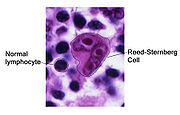
Reed-Sternberg cell
Encyclopedia

Cell (biology)
The cell is the basic structural and functional unit of all known living organisms. It is the smallest unit of life that is classified as a living thing, and is often called the building block of life. The Alberts text discusses how the "cellular building blocks" move to shape developing embryos....
s found with light microscopy in biopsies
Biopsy
A biopsy is a medical test involving sampling of cells or tissues for examination. It is the medical removal of tissue from a living subject to determine the presence or extent of a disease. The tissue is generally examined under a microscope by a pathologist, and can also be analyzed chemically...
from individuals with Hodgkin's lymphoma
Hodgkin's lymphoma
Hodgkin's lymphoma, previously known as Hodgkin's disease, is a type of lymphoma, which is a cancer originating from white blood cells called lymphocytes...
(aka Hodgkin's disease; a type of lymphoma
Lymphoma
Lymphoma is a cancer in the lymphatic cells of the immune system. Typically, lymphomas present as a solid tumor of lymphoid cells. Treatment might involve chemotherapy and in some cases radiotherapy and/or bone marrow transplantation, and can be curable depending on the histology, type, and stage...
) primarily due to EBV, and certain other disorders. They are usually derived from B lymphocytes
B cell
B cells are lymphocytes that play a large role in the humoral immune response . The principal functions of B cells are to make antibodies against antigens, perform the role of antigen-presenting cells and eventually develop into memory B cells after activation by antigen interaction...
.
They are named after Dorothy Reed Mendenhall
Dorothy Reed Mendenhall
Dorothy Mabel Reed Mendenhall was a well-known American pediatrician and discoverer of the Reed-Sternberg cell.right|thumb|200px|Dorothy Reed Mendenhall-Biography:...
(1874–1964) and Carl Sternberg (1872–1935), who provided the first definitive microscopic descriptions of Hodgkin's disease.
Reed–Sternberg cells are large and are either multinucleated or have a bilobed nucleus
Cell nucleus
In cell biology, the nucleus is a membrane-enclosed organelle found in eukaryotic cells. It contains most of the cell's genetic material, organized as multiple long linear DNA molecules in complex with a large variety of proteins, such as histones, to form chromosomes. The genes within these...
(thus resembling an "owl's eye" appearance) with prominent eosinophilic
Eosinophilic
Eosinophilic refers to the staining of certain tissues, cells, or organelles after they have been washed with eosin, a dye.Eosin is an acidic dye; thus, the structure being stained is basic....
inclusion-like nucleoli
Nucleolus
The nucleolus is a non-membrane bound structure composed of proteins and nucleic acids found within the nucleus. Ribosomal RNA is transcribed and assembled within the nucleolus...
. Reed-Sternberg cells are CD30
CD30
CD30, also known as TNFRSF8, is a cell membrane protein of the tumor necrosis factor receptor family and tumor marker.This receptor is expressed by activated, but not by resting, T and B cells. TRAF2 and TRAF5 can interact with this receptor, and mediate the signal transduction that leads to the...
and CD15
CD15
CD15 is a cluster of differentiation antigen - an immunologically significant molecule. CD15 is a carbohydrate adhesion molecule that can be expressed on glycoproteins, glycolipids and proteoglycans.- Function :...
positive, usually negative for CD20
CD20
B-lymphocyte antigen CD20 or CD20 is an activated-glycosylated phosphoprotein expressed on the surface of all B-cells beginning at the pro-B phase and progressively increasing in concentration until maturity....
and CD45
CD45
Protein tyrosine phosphatase, receptor type, C also known as PTPRC is an enzyme that, in humans, is encoded by the PTPRC gene. PTPRC is also known as CD45 antigen , which was originally called leukocyte common antigen.- Function :The protein encoded by this gene is a member of the protein tyrosine...
. The presence of these cells is necessary in the diagnosis of Hodgkin's lymphoma – the absence of Reed–Sternberg cells has very high negative predictive value
Negative predictive value
In statistics and diagnostic testing, the negative predictive value is a summary statistic used to describe the performance of a diagnostic testing procedure. It is defined as the proportion of subjects with a negative test result who are correctly diagnosed. A high NPV means that when the test...
. They can also be found in reactive lymphadenopathy
Lymphadenopathy
Lymphadenopathy is a term meaning "disease of the lymph nodes." It is, however, almost synonymously used with "swollen/enlarged lymph nodes". It could be due to infection, auto-immune disease, or malignancy....
(such as infectious mononucleosis
Infectious mononucleosis
Infectious mononucleosis is an infectious, widespread viral...
, carbamazepine
Carbamazepine
Carbamazepine is an anticonvulsant and mood-stabilizing drug used primarily in the treatment of epilepsy and bipolar disorder, as well as trigeminal neuralgia...
associated lymphadenopathy) and very rarely non-Hodgkin lymphomas.
A special type of Reed–Sternberg cells are lacunar histiocytes, whose cytoplasm retracts when fixed in formalin, so the nuclei give the appearance of cells that lie with empty spaces (called lacunae) between them. These are characteristic of the nodular sclerosis
Nodular sclerosis
Nodular sclerosis is a form of Hodgkin's lymphoma that is the most common subtype of HL in developed countries. It affects females and males equally and has a median age of onset at ~28 years...
subtype of Hodgkin's lymphoma.

